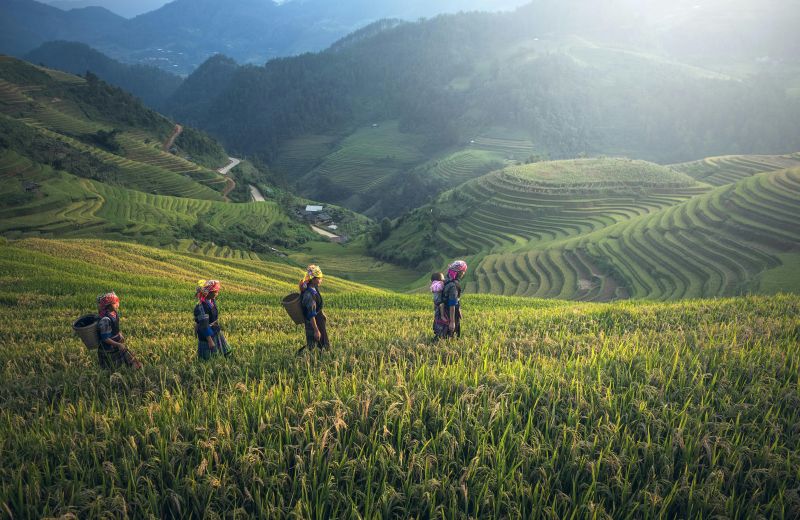Discover Africa's thriving agricultural practices, their economic impact, and challenges faced as well as promising solutions for a food-secure and prosperous future.

Top 5 African countries with the best Agricultural practices
Determining the best Countries with agricultural practices in Africa is quite challenging due to the vastness and diversity of Africa's agricultural landscape.
However, several countries consistently rank high in terms of innovation, production, and sustainability.
Here are five African countries with noteworthy agricultural achievements:
Morocco
Morocco has made significant strides in modernizing its agricultural sector. They've invested heavily in irrigation infrastructure, adopted water-efficient technologies, and promoted the use of high-yielding crop varieties. Morocco is a major producer of citrus fruits, vegetables, and olives.
Ghana
Ghana is a leader in West Africa for its adoption of sustainable agricultural practices. They actively promote cocoa agroforestry, which integrates cocoa trees with other crops and trees, fostering biodiversity and soil health. Ghana is also a major producer of cassava, yams, and plantains.
Ethiopia
Ethiopia has made impressive progress in improving food security through investments in rural infrastructure and extension services. They've also emphasized soil and water conservation practices. Ethiopia is a major producer of teff, a grain used to make injera, a staple food.
Kenya
Kenya is a leader in East Africa for its great and diversified agricultural sector. They actively promote agribusiness and innovation, with a focus on high-value crops like coffee, tea, and flowers. Kenya is also a major producer of maize and vegetables.
Rwanda
Rwanda has undergone a remarkable agricultural transformation in recent years. They've implemented a land consolidation program to improve efficiency and promote mechanization. Rwanda is also a strong proponent of climate-smart agriculture. Rwanda is a major producer of coffee, tea, and pyrethrum, a natural insecticide.
Economic Impact of Agriculture in Africa
Agriculture plays a pivotal role in Africa's economy and development. Let's see how successful agriculture cultivates growth in several key areas:
Increased Exports and Foreign Exchange Earnings:
High-yielding crops and livestock become valuable commodities for international trade. By exporting surplus food products, a nation generates foreign exchange, which can be used to import essential goods and technologies, further propelling economic development.
Job Creation in Farming and Related Sectors:
It goes beyond just farmers; jobs arise in transportation, storage, food processing, agricultural machinery production, and a range of other sectors that support the farm-to-table journey. This creates a ripple effect, boosting incomes and stimulating local businesses.
Improved Food Security and Reduced Malnutrition:
When agriculture thrives, a nation becomes less reliant on food imports and better equipped to feed its population. This ensures a stable supply of nutritious food, promoting better health outcomes and reducing malnutrition, especially among vulnerable populations.
Overall Economic Diversification and Stability:
A thriving agricultural sector lessens a nation's dependence on a single industry. It also encourages investment in rural areas, fostering balanced development across the country.
Challenges and Solutions
Regardless of the success stories or achievements in African Agricultural practices so far, the challenges remain.
This section vividly explains these challenges and explores promising solutions.
Common Challenges:
Droughts, floods, and climate extremes: Erratic weather patterns disrupt planting cycles, devastate crops, and threaten food security.
- Limited access to finance and technology: Many farmers lack the capital to invest in modern equipment, fertilizers, and drought-resistant seeds, hindering productivity.
- Poor infrastructure and market access: Inadequate transportation networks and storage facilities lead to post-harvest losses, while limited market access restricts farmers' ability to connect with buyers and secure fair prices.
- Land degradation and pest infestations: Overgrazing, deforestation, and overuse of chemicals contribute to soil erosion and decreased fertility. Additionally, pest infestations wreak havoc on crops, diminishing yields.
Promising Solutions:
- Investment in climate-smart agriculture: This approach prioritizes practices that enhance resilience to climate change. Techniques like rainwater harvesting, drought-resistant crops, and conservation tillage can empower farmers to adapt and thrive in a changing climate.
- Public-private partnerships for infrastructure development: Collaborative efforts between governments and private entities can bridge the infrastructure gap. Building better roads, storage facilities, and irrigation systems will connect farmers to markets, reduce post-harvest losses, and enable them to reach their full potential.
- Microfinance initiatives for rural farmers: Microfinance institutions can provide small, accessible loans tailored to the needs of rural farmers. This financial inclusion empowers them to invest in essential tools, seeds, and irrigation, ultimately propelling agricultural growth.
- Research and development for sustainable practices: Increased investment in research can lead to the development of disease-resistant crops, improved soil management techniques, and innovative pest control solutions.
Conclusion
Africa's agricultural landscape is rich with potential. A spirit of innovation is driving progress, as we have discovered from these few selected thriving African Countries, among others.
However, challenges like climate change and limited resources remain. By prioritizing climate-smart practices, investing in infrastructure, and empowering farmers through microfinance and research, Africa can overcome these hurdles and unlock a food-secure and prosperous future.

